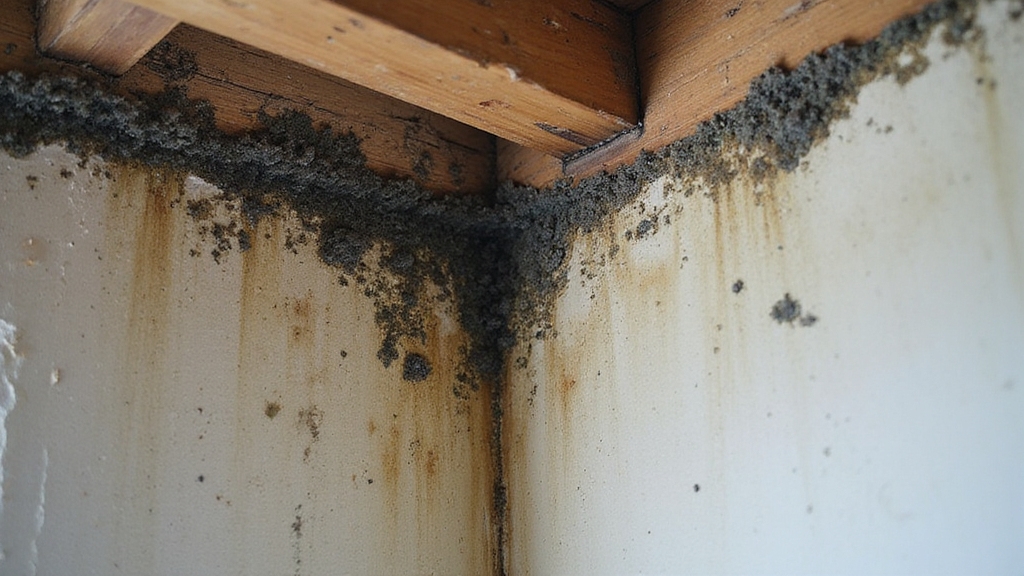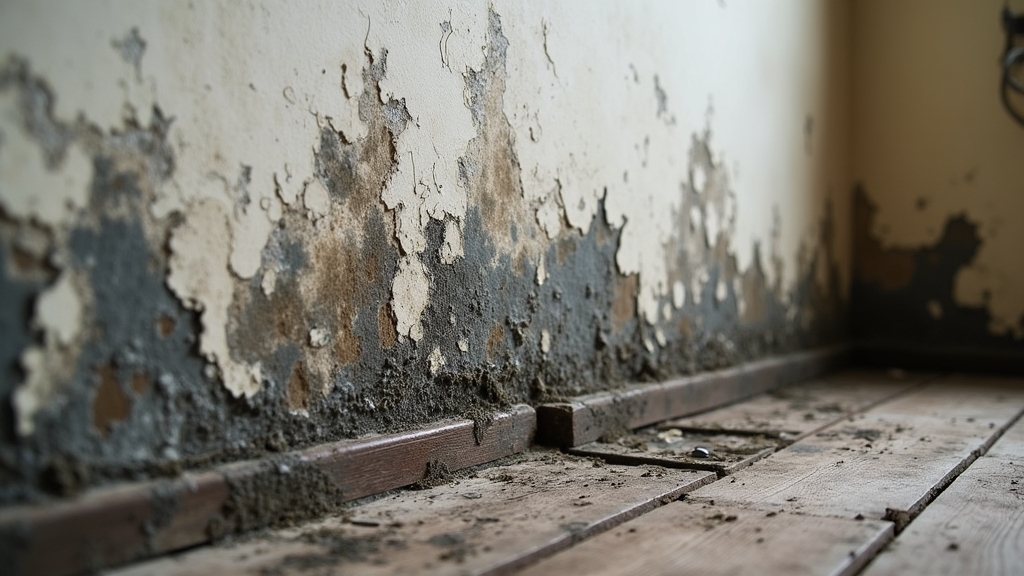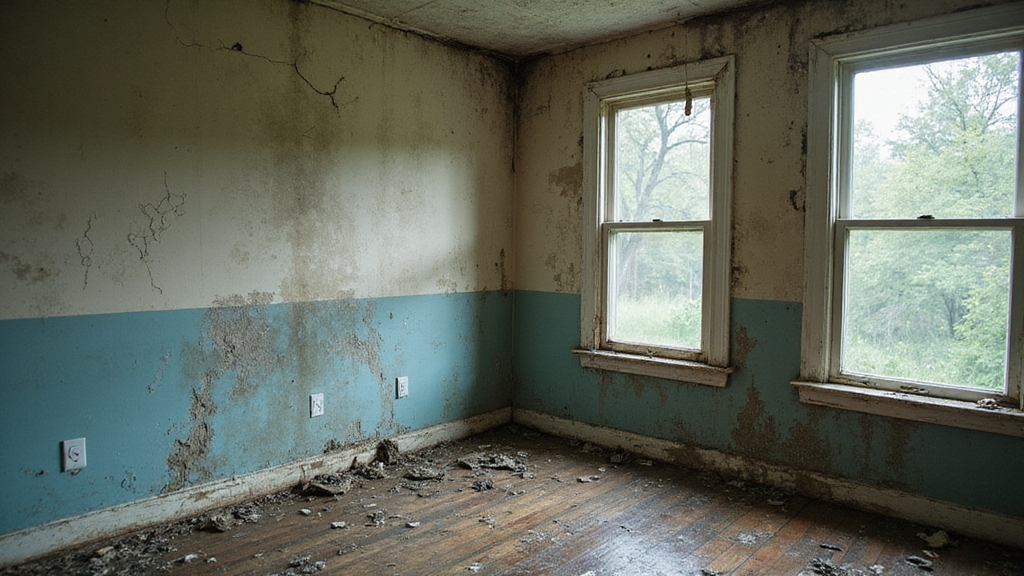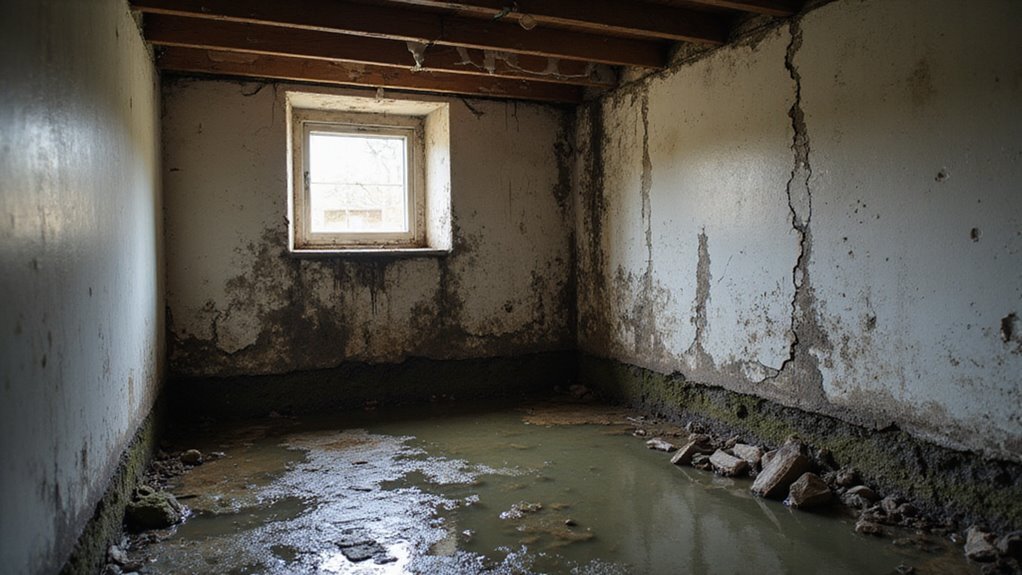Mold and water damage can seriously hurt your home’s value. Buyers, lenders, and inspectors all see these problems as warning signs. These issues often lead to lower offers or failed sales.
These problems do not just look bad—they can mean bigger trouble inside your walls and floors. Hidden damage may cost thousands to fix.
You might also face health risks and expensive repairs. Mold and water damage lower your home’s value by making it less safe, less attractive, and more expensive to maintain.
Quick repairs and proper prevention protect your investment and make selling easier. This blog will guide you through spotting, fixing, and preventing mold and water damage to protect your home’s value.
Key Takeaways
- Mold and water damage typically lower a home’s appraised value due to repair costs and perceived risks.
- Visible stains, odors, and damage make homes less appealing, reducing buyer interest and demand.
- Lenders may deny loans or require higher down payments for properties with mold or water damage.
- Ongoing moisture or mold issues raise health and safety concerns, further decreasing property value.
- Sellers must disclose known damage; failure to do so can lead to legal and financial consequences.
Understanding the Causes of Mold and Water Damage

Mold spores are almost always present indoors. If you let moisture stay, these spores can quickly grow and spread. Any damp area with materials like wood or drywall is at risk. Proper mold management is essential to prevent health issues and property damage.
Ignoring small leaks or humidity problems can make things worse. If you fix these issues early, you can prevent major damage. Understanding how moisture leads to mold helps you protect your home and reduces the risk of additional water damage.
Common Signs of Mold and Water Issues in Homes
Even small amounts of extra moisture can mean mold or water damage in your home. Discoloration or stains on ceilings or walls often show hidden leaks. A musty smell, especially in basements or bathrooms, usually points to mold.
Paint that bubbles or peels can mean moisture is trapped inside the wall. Warped floors or sagging drywall are signs of serious damage. Condensation on windows or visible mold spots also need quick attention.
Early detection helps prevent bigger problems. If you notice any of these signs, act fast to stop more damage. Fixing issues early can save money and protect your home’s value. Understanding proper pricing strategies can also ensure you maximize your home’s market potential after repairs.
Being aware of neighborhood comps can help you assess the true impact of repairs on your home’s value and make informed decisions during the selling process.
Health Risks Associated With Mold Exposure

Mold exposure can cause health problems, especially if you have allergies, asthma, or a weak immune system. Mold grows in damp places and releases spores that can make you sick. Common symptoms include sneezing, coughing, skin irritation, wheezing, and headaches.
Selling Your Home to Cash Buyers in Divorce Cases can sometimes be expedited by addressing such issues promptly. Children, the elderly, and people with sensitive skin are at higher risk. If you have asthma or allergies, you may react more strongly to mold. Anyone living in a moldy home can develop symptoms. You can reduce the risk by using mold-resistant materials and fixing leaks quickly.
Keeping humidity low helps prevent mold growth. Regularly checking your HVAC system and reviewing your water damage insurance are also important steps. Understanding the importance of property condition disclosures can help homeowners avoid legal issues related to mold.
Structural Impacts of Water Damage
You can’t ignore how water damage threatens your home’s structural stability, especially when it compromises the foundation. Moisture often seeps into hidden areas, causing wall deterioration that’s not always visible until the damage is extensive. Recognizing these risks early protects your property and prevents costly repairs.
Additionally, water infiltration can weaken support beams and lead to potential safety hazards if left unaddressed. It’s essential to understand how water-related issues can impact building integrity and address them promptly.
Compromised Foundation Integrity
Water can weaken your home’s foundation if it gets into the ground around your house. This extra moisture puts pressure on the foundation and may cause cracks or shifting. If these problems start, the whole structure of your home is at risk.
Early signs of foundation damage include uneven floors or doors that stick. Windows may also develop gaps around the frames. If you ignore these issues, your home’s value and safety may decrease.
Proper drainage and moisture control protect your foundation. If you manage water well, you help keep your home strong and safe. Regular checks and quick repairs can prevent bigger problems.
Hidden Wall Deterioration
Hidden wall deterioration happens when moisture gets inside your walls and causes slow damage. This damage is often hidden until it becomes serious. If you ignore it, your home may need expensive repairs and lose value.
Moisture can make drywall swell, bend, or fall apart behind paint or wallpaper. Insulation inside your walls can also get wet and stop working well. Damaged insulation may raise your heating and cooling bills.
If water stays inside walls, it can rust metal supports and fasteners. Rust weakens the structure and makes your home less safe. Moisture also helps mold grow, which can further harm your walls.
You should check for these signs if you suspect water is getting into your walls. Early action can protect your home and save you money.
How Mold and Moisture Affect Home Inspections

Mold and moisture can cause serious problems during home inspections. These issues weaken a home’s structure and lower indoor air quality. Inspectors always check for them because they affect the safety and value of the home.
Home inspectors look for visible mold, musty smells, and signs of water damage. They may use special tools to find moisture hidden in walls or under floors. If mold or moisture is found, they will recommend quick action. Understanding market trends can help homeowners prioritize repairs that will most effectively protect their property value and facilitate a smoother sale.
A report with mold or moisture problems can change your plans as a homeowner. Buyers and lenders may require repairs before moving forward. If you address these problems early, you protect your property and make selling easier.
Buyer Perceptions and Concerns
Buyers often worry when they see mold or water damage in a home. These problems can make buyers hesitate, even if the house looks nice. People want to feel safe and avoid costly repairs.
Mold can cause health problems, especially for those with allergies or asthma. If buyers think the home has mold, they might look elsewhere. They may feel the risk is not worth it.
Water damage can mean deeper issues, like problems with the structure or foundation. Buyers may worry about hidden costs. If repairs seem expensive, buyers could lose interest.
If a home has a history of water or mold damage, resale can be harder. Buyers might expect future problems when it comes time to sell. Even good landscaping or decor may not change their minds.
Water and mold damage can significantly impact a home’s value and buyer perceptions. Understanding the importance of a clear title can help homeowners address potential legal issues that may arise from these damages.
Impact on Appraisal and Market Value
You’ll notice that mold and water damage almost always lead to lower appraisal values, as appraisers factor in both visible issues and potential underlying problems. When buyers sense risk or expect costly repairs, their demand drops, and they’re quick to negotiate significant deductions for remediation.
These factors combine to erode your home’s market value more than many other common defects. Additionally, the presence of water damage can lead to additional financial risks that further diminish property worth.
Reduced Property Appraisal Figures
Mold or water damage will lower your property appraisal. Appraisers focus on both the look and the condition of your home. Visible problems can make your home worth less.
If there are signs of mold or water issues, value goes down. Appraisers subtract repair costs from your home’s worth. They also compare your home to others with similar problems.
Ongoing moisture or mold raises concerns about future repairs. This risk makes buyers and appraisers less confident in your property. Fixing these issues early can help you avoid a lower appraisal.
Buyer Perception and Demand
Buyers notice mold or water damage quickly. These problems make them worry about the home’s condition. If buyers see stains or smell dampness, they may lose interest right away.
Home staging cannot hide obvious issues like ceiling stains or musty odors. Even a beautiful home loses appeal if buyers suspect hidden damage. Demand for your home will likely drop in this situation.
A nice neighborhood cannot fully offset visible problems inside the home. Buyers might fear future repairs or ongoing moisture issues. If demand falls, both your home’s value and appraisal can decrease.
Increased Repair Cost Deductions
Increased repair cost deductions lower your home’s value if there is mold or water damage. Appraisers estimate how much repairs will cost and subtract this from your home’s value. Even small signs of damage can lead to big deductions.
Lenders may refuse loans or ask for bigger down payments if damage is found. Buyers usually want lower prices to cover their own repair costs. Insurance costs may also rise, and this can lower your home’s value even more.
If there are other problems with the home, repair deductions can add up. Understanding these deductions helps you manage home sales with water or mold damage. Being aware of these risks is important for both sellers and buyers.
Legal Disclosure Requirements for Sellers
Legal obligations require sellers to share known mold and water damage issues. Sellers must give honest and full information about the property. Accurate disclosure is needed to meet the law. Property disclosure laws require full transparency about known faults and damages.
Most states have forms that ask about mold and water problems. Sellers must fill these out truthfully. If they do not, they risk fines or lawsuits. Penalties for not disclosing can include financial loss or even canceling the sale. Buyers depend on this information to decide on the purchase. Honest answers help avoid legal problems and build trust.
Insurance Challenges Related to Mold and Water Damage
When you face mold or water damage, you’ll quickly notice that most insurance policies have strict coverage limitations and exclusions. Insurers are increasingly denying claims, often citing maintenance issues or pre-existing conditions. Even if your claim is approved, expect your premium rates to rise, reflecting the higher risk your home now represents.
Policy Coverage Limitations
Insurance policies often have limits on mold and water damage coverage. These limits can leave you paying for expensive repairs. Policyholders should know what their insurance does and does not cover.
Many policies set a cap on how much they will pay for mold damage. If the repair costs exceed this cap, you must pay the rest. Some policies exclude mold damage caused by long-term leaks.
Insurers may hide loopholes in policy language. If the damage happens slowly, your claim might get denied. Most policies require the cause to be sudden and accidental.
If you want better protection, review your policy carefully. You may need extra coverage for full protection against mold and water damage. Always ask your insurer about any unclear terms.
Claim Denials Increase
Claim denials for mold and water damage are rising. Insurers often say the damage is due to neglect or slow response. They may refuse your claim if you did not act quickly.
If you do not document each step of mold cleanup, your insurer could deny coverage. Most policies do not cover damage that happens slowly over time. Gradual issues, like long-term leaks, often lead to claim denials.
You should act fast when water damage occurs. Take photos, keep records, and follow professional cleanup methods. Quick action and proper documentation help protect your claim if the insurer questions it.
Premium Rate Impact
Premium rates for mold and water damage insurance have increased in recent years. Homes with a history of these problems often face higher costs. Insurers consider such homes to be higher risks.
If you have filed a water damage claim before, your insurer may add a surcharge. Some companies might remove or limit coverage for mold. This can mean less protection for your home.
Higher premiums may make it harder to sell your property. Buyers often avoid homes with expensive insurance costs. Regular inspections and timely repairs can help keep your coverage active.
You should understand these insurance issues before making decisions about your home. Careful planning helps protect your property and your wallet.
Cost of Remediation and Repairs
When you identify mold or water damage in your home, understanding the possible costs of remediation and repairs becomes critical for effective decision-making. Accurate cost estimation depends on the extent of the damage, the specific areas affected, and the materials involved.
Minor repairs, such as drywall replacement or localized cleaning, might be manageable, but significant infestations or structural damage can drive costs much higher. You’ll need to factor in professional remediation services, which often involve mold containment, removal, and post-treatment verification.
Repair procedures typically require replacing compromised materials and addressing the source of moisture to prevent recurrence. It’s wise to obtain multiple quotes from certified contractors to ensure fair pricing and comprehensive service. Investing in prompt, thorough repairs protects both your home’s value and your peace of mind.
Preventative Measures to Avoid Mold and Water Problems
You can greatly reduce your risk of mold and water damage by scheduling regular home inspections, ensuring proper ventilation, and addressing leaks promptly. These steps target the root causes before they intensify into costly problems. By prioritizing prevention, you protect your home’s structure, air quality, and long-term value.
Additionally, being aware of damaged houses in your area can help you identify properties that may be at higher risk for water-related issues. Implementing preventative maintenance measures such as gutter cleaning and sealing foundation cracks further diminishes the likelihood of water infiltration and mold growth.
Regular Home Inspections
Regular home inspections help prevent mold and water damage in your house. If you make inspections a habit, you can catch problems early. This protects your home and saves money on repairs.
An inspection checklist helps you find trouble spots. You should look for leaks, dampness, or musty smells in attics and basements. Inspect plumbing under sinks, around toilets, and near appliances for moisture.
Check outside walls, gutters, and roofs for cracks or drainage problems. Review seals around windows, doors, and tubs for signs of wear. If you find small issues, fix them quickly to avoid bigger damage.
Proper Ventilation Practices
Proper ventilation helps prevent moisture and mold in your home. Good airflow removes humid air and brings in fresh air. This keeps indoor air clean and reduces mold risk.
Use exhaust fans in kitchens and bathrooms to move damp air outside. Make sure your HVAC system gets regular maintenance. If weather allows, open windows to let in natural air.
If you manage airflow well, you protect your home from mold and water damage. This also creates a healthier place to live. Ventilation is a simple way to care for your home.
Timely Leak Repairs
Unrepaired water leaks can cause mold and damage your home’s structure. Fixing leaks quickly will protect your home’s value. Even small leaks can increase basement dampness and harm air quality.
Regular checks help you catch leaks early. If you see a leak, repair it right away to avoid bigger issues. A simple checklist can make prevention easier.
Inspect plumbing fixtures and appliances for leaks every few months. Use a dehumidifier if basement humidity rises. Keep gutters clear so water flows away from your home.
Check your roof and windows for leaks after storms. If you spot moisture, dry the area and make repairs. Early action will save you time and money.
Staging a Home After Mold or Water Damage
Staging a home after mold or water damage helps restore buyer trust and protect your home’s value. Buyers often hesitate to purchase homes with past water issues. Showing your repair efforts is important.
Display records or warranties that confirm professional cleanup and repairs. Fresh paint and clean surfaces help remove memories of past damage. Neutral smells and tidy spaces are also important.
Use good lighting and modern, simple furniture to create a welcoming feel. If needed, run dehumidifiers or air purifiers during showings. These steps show buyers you have taken care of the home.
If you focus on air quality and humidity control, buyers will feel safer. Proper staging shows you are proactive about maintenance. This approach helps your home stand out in the market.
Working With Real Estate Agents to Address Concerns
A real estate agent can help address buyer concerns about mold or water damage. Agents provide proof of repairs and explain the steps taken. They make your home more appealing and help buyers feel confident.
You should give your agent official reports from the repair companies. These documents show that professionals fixed the issues. If warranties transfer to the new owner, your agent should highlight them.
Before-and-after photos can help buyers see the improvements. Your agent should also have a clear timeline of when problems were found and fixed. These details can reduce doubts if buyers are uncertain.
Working closely with your agent ensures all information is accurate and complete. If you follow these steps, you can make the selling process smoother. This approach may also help you get better offers.
Long-Term Effects on Neighborhood Values
Mold and water damage can lower neighborhood property values over time. These problems show that homes are not well cared for. If many houses have these issues, the whole area may lose value.
People may feel unsafe in neighborhoods where homes look neglected. Potential buyers may avoid these areas, fearing health problems or extra costs. As a result, fewer people are willing to invest or renovate.
If you address mold and water problems quickly, your community will benefit. Healthy homes make neighborhoods safer and more attractive. If everyone works together, property values are more likely to rise.
Conclusion
If mold or water damage remains unaddressed, a home’s value and appeal can quickly decline. Buyers may hesitate if they notice these problems. If you want to maintain your property’s worth, it is important to address damage as soon as possible.
If you need to sell your home quickly, we buy houses for cash, even those with mold or water issues. Limitless Homes of KC understands these challenges and offers fair solutions. If you want a simple and fast sale, we can help.
If you are ready to move forward, contact us today. We can answer your questions and guide you through the cash sale process. Let Limitless Homes of KC make selling your home easy and stress-free.

